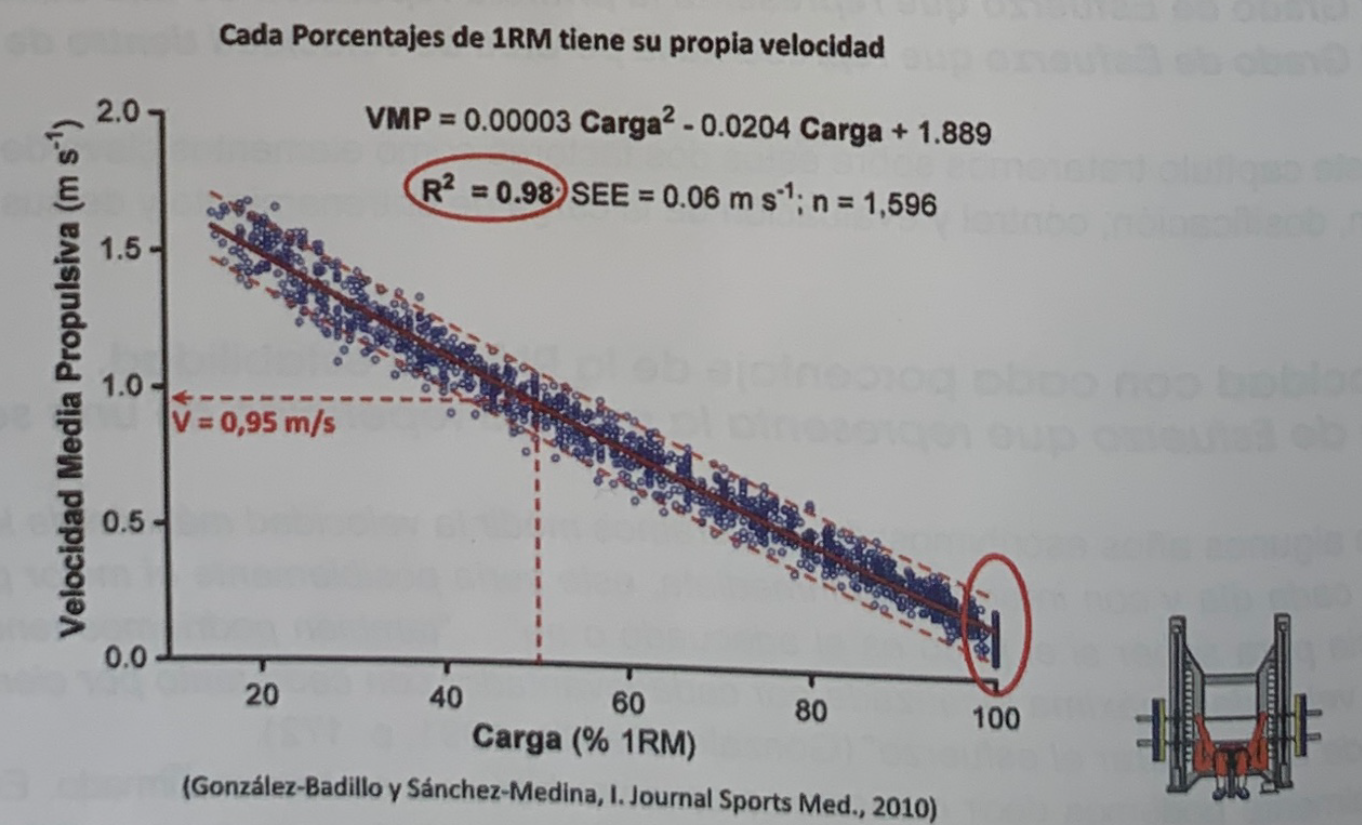Acute fatigue of 15 types of efforts with external loads
The following article analyzes several studies carried out to analyze acute fatigue in different types of efforts and its relationship with the loss of execution speed.
In this series of articles we deal with some of the most important concepts of strength training, collecting notes from the recently published book Strength, Speed and Physical and Sports Performance written by renowned researchers Juan José González Badillo and Juan Ribas Serna.
SUMMARY
- Fatigue directly depends on the loss of speed in the series, regardless of the number of repetitions that can be done with the load being trained.
- The measurement of fatigue after an effort to exhaustion when moving loads should be done especially through speed and RFD (force production per unit of time).
In a study carried out by Sánchez-Medina and González-Badillo in 2011, the loss of speed in the series (at the end of three sets with the same absolute load) by performing at the maximum speed possible 15 different types of effort with the bench press and squat exercises. These efforts are expressed in terms of Character Effort (EC), such as: 3×6(12), where the first number expresses the number of sets, the second the number of repetitions performed, and the number in parentheses the number of possible repetitions in the set.
The efforts were as follows: 3×6(12), 3×8(12), 3×10(12), 3×12(12), 3×6(10), 3×8(10), 3×10(10), 3×4(8), 3×6(8), 3×8(8), x3(6), 3×4(6), 3×6(6), 3×2(4), 3×4(4). The approximate percentages of 1RM that these loads represent are the following: 70% for 12 possible repetitions, 75% for 10, 80% for 8, 85% for 6 and 90% for 4, although the subjects made the efforts with the absolute loads that could move the maximum repetitions under analysis at the maximum possible speed: 12, 10, 8, 6 and 4, not the percentages that represent this number of reps. requests.
En la figura 1 se puede observar un ejemplo de uno de los esfuerzos [3×12(12)].

Figure 1. Example of speed evolution when three sets of 12 repetitions are performed with a load with which only 12 repetitions can be done. The loss of speed (fatigue) can be observed within each series and in the total of the series. Fatigue is estimated by the loss of speed with the load that could be moved at 1 m*s-1 (average 1.03 m*s-1 in three repetitions) before the first series. The loss of speed reached 31.1% (average speed 0.71 m*s-1) after the last repetition of the last series. (Sánchez-Medina and González-Badillo, 2011).
Figures 1 and 2 show the relationship between the loss of speed in the line and the loss of speed with the load that had moved 1 m*s-1 before carrying out each one of the efforts. The high relationship between the compared variables indicates that the loss of speed in the series, at least between 70% and 90% of 1RM, is an accurate estimator of the degree of fatigue generated by training in both exercises.
acute fatigue depends directly on the loss of speed in the series, regardless of the number of repetitions that can be done with the load that is trained
In addition, it can be stated that fatigue directly depends on the loss of speed in the series, regardless of the number of repetitions that can be done with the load being trained. This affirmation is based on the fact that for intervals of 5-7% of losses in the series (axis X) occur with similar losses of speed with the load of 1 m*s-1 belonging to the different types of effort (axis Y). Result. two similar ones were obtained when the relationship between the speed losses in the series and the height loss in the vertical jump was calculated (figure 2).

Figure 2. Correlation between the loss of mean propulsive velocity (VMP) in the series and the loss of VMP with the load of 1 m*s-1 in the bench press exercise. Each color represents the CE with a different maximum number of repetitions/series (blue: 12 possible repetitions; yellow: 10; green: 8; pink: 6; red: 4) (Sánchez-Medina and González-Badillo, 2011).
The results of this study indicate that regardless of the cause, within the intensity ranges studied, the fatigue caused by a training session with loads depends on the percentage of speed loss in the series (at the end of the three series, in this case), regardless of the number of repetitions that can be performed in the series itself.
This conclusion is justified by the close relationship between the speed losses in the series and the speed loss with the load of 1 m*s-1 and the height loss in the vertical jump. In turn, the loss of speed with the load of 1 m*s-1 and the loss of height in the vertical jump are precise estimators of the metabolic stress caused by the training session, naturally due to the high relationship of these variables with the concentration of lactate and ammonium.
It is also noteworthy that, if we take the ammonium concentration as a reference, when the speed losses in the series (the three series) do not exceed 30% in the squat or 40% in the bench press, it seems that the emergency pathway of energy production is set in motion, so fatigue does not seem to be excessive in these cases.
Therefore, speed control not only allows estimating the degree of fatigue, but in this case it informs us about the possible consequences if certain physiological stress barriers are overcome. The causes of loss of speed within the series and the loss of speed cal the load of 1 m*s-1 and the vertical jump can be associated with those that we have indicated for the efforts of short duration.
Therefore, the results of this study lead to reflection and conclusion that it cannot be affirmed that the greater the absolute intensity at which an activity is carried out until exhaustion, the greater the fatigue.
It can be affirmed that the time or the number of repetitions that this intensity can be supported will be less. In other words, muscular failure, exhaustion, is reached sooner, and therefore fatigue develops more quickly the higher the intensity, but the fatigue does not have to be greater, rather it will actually tend to be less.
In this case, it is observed that fewer repetitions per series can be done the higher the load or intensity (1RM percentage), and therefore muscle failure and exhaustion are reached earlier, but fatigue is less: less speed loss in the series and with the load of 1 m*s-1 and less height loss in the post-effort vertical jump.
From this conclusion it should not be deduced that training with external loads should be done with the highest intensities, because this would generate less fatigue. Other factors such as the absolute speed of execution, maximum and average, the nature of the effort and the number of total repetitions to be performed are determining factors in the training effect.

Fatigue in a dynamic effort with loads to exhaustion
In the laboratory, the authors carried out a study in which they tried to verify the degree of fatigue and the post-effort recovery time of a dynamic exercise, measured through the changes in force, speed and RFD (rate of force development or force per unit of time) in a static and a dynamic test (Rodríguez-Rosell, Doctoral Thesis).
To do this, 28 physically active subjects, with experience in strength training, performed a test to muscular failure in the bench press exercise with a load that they were capable of moving at a speed of -0.78 m/s (-60% of 1RM). Before, immediately after, and at 3, 5, 10, 15, and 20 min after finishing the effort, an isometric and a dynamic measurement were made.
The degree of fatigue and recovery in the dynamic measurement was determined by the performance with the load that could be moved at 1 m*s-1, which was measured before the effort and in the six moments after the effort. In the dynamic measurement, the variables analyzed, among others, were the Mean Propulsive Velocity (MPV), Peak Force (PF), Peak Velocity (PV), and Maximum Force Production in Unit Time (MRFD), The first observation is that the loss of the values of these variables is not linear through the total number of repetitions performed until exhaustion.
When comparing the loss during the first and second half of the total number of repetitions performed, it was observed that the losses in the second half were significantly higher than in the first half in all variables. The VMP (43%) and the PV (43.5%) were the variables that lost the most in the second half with respect to the first, followed by the MRFD (38.6%) and, to a lesser extent, the PF (12%).

Immediately after the effort, the yield loss percentages were 58.4 in the VMP, 59.3 in the PV, 65.8 in the MRFD and 28.9 in the PF. At 20 minutes after the effort (last post-exercise test), none of the variables had recovered in a statistically significant way, although with a greater recovery ra of the PF variable with respect to the other three.
The values of these variables at the end of 20 minutes of recovery with respect to the initial test were 89.1 (VMP), 86.8 (PV), 83.9 (MRFD) and 94.6% (PF).
Furthermore, the RED values at times 0-50, 0-75 and 0-100 ms also did not recover significantly at the end of 20 min. From these results it can be deduced that speed and force production in unit time are much more sensitive to fatigue than the applied peak force.
Therefore, the measurement of fatigue after an effort to exhaustion when moving loads should be done especially through speed and RFD, since if only the peak force is measured, the information may be erroneous.
Given the difficulty of measuring RFD in most cases, speed once again appears as the best way to control the degree of fatigue and recovery after exertion.
In the static or isometric measurement, the MRFD was at 77.8% of the initial value] at 20 minutes of recovery, while the PF was at 96.3% of the initial value. In the test immediately after the effort, the MRFD lost 66.6% and the PF 29.9%.
As in the assessment of fatigue through dynamic measurement, in static action the MRFD is much more sensitive to fatigue than the peak force. The PF value was no longer significantly different from the initial test at 20 minutes, while the MRFD was.
Therefore, in static actions, fatigue can also be assessed more precisely through the production of force in the unit of time than by the peak force reached. It can be seen that the yield loss and recovery values were similar when evaluating them through dynamic and static action.
Similar results were found by Buckthorpe et al., (2014), who, after carrying out repeated efforts in an explosive manner, verified that the RFD declined faster and more pronouncedly than the maximum force. The initial phase of the RFD (0-50 ms) was especially sensitive to fatigue. According to these authors, both neural (central fatigue) and contractile (peripheral fatigue) mechanisms seem to contribute to the reduction of RFD and maximum force.









